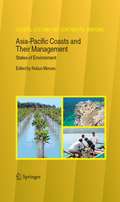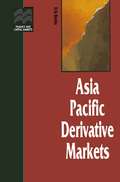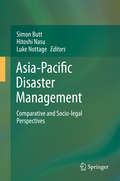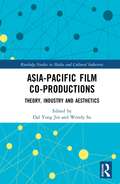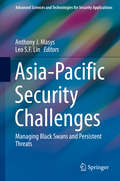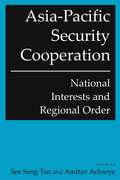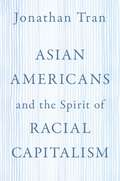- Table View
- List View
Asia-Pacific Coasts and Their Management: States of Environment (Coastal Systems and Continental Margins #11)
by Nobuo MimuraThe Asia and Pacific region is home to the world’s largest concentration of coral reefs and mangroves. It accommodates two-thirds of the world’s human population and its economic activities have the highest growth rate in the world. This book gives an overview of the state-of-the-art understanding on the drivers, state, and responses to the coastal environmental changes in the Asia and Pacific region. It provides important perspectives on the subject for researchers.
Asia-Pacific Contemporary Finance and Development (International Symposia in Economic Theory and Econometrics #26)
by William A. Barnett Bruno S. SergiAsia-Pacific Contemporary Finance and Development collects a well-informed range of fourteen chapters, investigating banking, finance, production, and consumer sectors that are vital shares of modern economies and definitive drivers of growth in the Asia-Pacific economies. The chapters, authored by internationally renowned and experienced academics, showcase the most updated economic and entrepreneurial dynamism in the Asia-Pacific, a large and thriving region that is recognized as a driving force of innovation and economic growth worldwide. From the TPP and the U.S., to short-term cross-currency basis swap and Japanese government bond markets, and from volatility and risk-taking firms and corporate diversification strategy and the political effects of the Corporate Social Responsibility, to consumption propensity and entrepreneurship, this volume of The International Symposia in Economic Theory and Econometrics explores and investigates contemporary challenges and issues facing the Asia-Pacific economies. For researchers and students of economics and finance, this volume is a fascinating exploration of emerging topics in one the fastest growing economies in the world.
Asia-Pacific Contemporary Finance and Development: Proceedings Of The Tenth International Symposium In Economic Theory And Econometrics (International Symposia in Economic Theory and Econometrics #26)
by William A. Barnett Bruno S. SergiAsia-Pacific Contemporary Finance and Development collects a well-informed range of fourteen chapters, investigating banking, finance, production, and consumer sectors that are vital shares of modern economies and definitive drivers of growth in the Asia-Pacific economies. The chapters, authored by internationally renowned and experienced academics, showcase the most updated economic and entrepreneurial dynamism in the Asia-Pacific, a large and thriving region that is recognized as a driving force of innovation and economic growth worldwide. From the TPP and the U.S., to short-term cross-currency basis swap and Japanese government bond markets, and from volatility and risk-taking firms and corporate diversification strategy and the political effects of the Corporate Social Responsibility, to consumption propensity and entrepreneurship, this volume of The International Symposia in Economic Theory and Econometrics explores and investigates contemporary challenges and issues facing the Asia-Pacific economies. For researchers and students of economics and finance, this volume is a fascinating exploration of emerging topics in one the fastest growing economies in the world.
Asia Pacific Derivative Markets (Finance and Capital Markets Series)
by Erik BanksErik Banks, responsible for global risk management at Merrill Lynch in Hong Kong, has written another text on the derivatives field covering innovation in these instruments in Asia Pacific. The text acts as a detailed reference on the nature of these markets and the prospects for the Asian derivative markets, both listed and OTC. He also includes an analysis of the Australian, New Zealand and Japanese markets to fit the emerging markets into context.
Asia-Pacific Disaster Management: Comparative and Socio-legal Perspectives
by Simon Butt Hitoshi Nasu Luke NottageThe book outlines the regulatory environment for disaster prevention and management in broad social, economic and political context. The first half of the book focuses mainly on Japan, especially the ‘3-11’ events: the earthquake and tsunami that devastated the Tohoku area on 11 March 2011 and the Fukushima Daiichi nuclear power plant radiation leaks. The second half focuses on the USA (the only other Asia-Pacific country to have experienced a serious nuclear emergency), Indonesia, China, New Zealand, Australia and international law. One question explored is whether socio-legal norms play different roles in preventing and managing responses to natural disasters compared to ‘man-made’ disasters. Another is how ‘disaster law’ interacts with society across very diverse societies in the disaster-prone Asia-Pacific region. The book also addresses the increasingly important roles played by international law and regional regimes for cross-border cooperation in disaster prevention and relief, including the functions played by military forces.Erudite, pragmatic, and charged with detailed, substantive knowledge of an astonishing range of contexts and research fields, this timely collection of important essays on the law and society of disaster management stands as an exemplary international academic response to the disasters of 11 March 2011. (Annelise Riles)
Asia-Pacific Economic and Security Co-operation: New Regional Agendas
by C. DentThis collection examines new developments in economic and security co-operation in the Asia-Pacific in relation to two recent 'shock' events that have significantly impacted upon the region, these being the 1997/98 East Asian financial crisis and the September 11 attacks on the United States. These are examined through three 'prime dimensions' of analysis, namely: the tension between the 'post-shock' forces of 'imperative co-operation' and the counter-forces of Asia-Pacific 'complex diversity'; the growing conflation between economic and security issues - or the 'economics-security nexus' - in Asia-Pacific international relations; the relationship between the Asia-Pacific's new economic and security bilateralism and regional-level forms of co-operation, integration and governance.
Asia Pacific Economic Cooperation: Challenges and Tasks for the Twenty First Century (PAFTAD (Pacific Trade and Development Conference Series))
by Ippei YamazawaThis book provides the most up-to-date and comprehensive account of the APEC (Asia Pacific Economic Cooperation) organisation and examines the challenges APEC now faces in the new century. Subjects covered include:* the history of APEC* APEC and the latest WTO round* case-studies of countries in the region including China, Japan, Malaysia, Korea and Taiwan* APECs approach to competition and deregulation policy* assessment of APECs standing as an international institutionFeaturing contributions from distinguished groups of international academic experts, this book is essential reading for all those interested in political and economic developments in the Asia-Pacific.
Asia Pacific Economic Cooperation: Challenges and Tasks for the Twenty First Century (PAFTAD (Pacific Trade and Development Conference Series))
by Ippei YamazawaThis book provides the most up-to-date and comprehensive account of the APEC (Asia Pacific Economic Cooperation) organisation and examines the challenges APEC now faces in the new century. Subjects covered include:* the history of APEC* APEC and the latest WTO round* case-studies of countries in the region including China, Japan, Malaysia, Korea and Taiwan* APECs approach to competition and deregulation policy* assessment of APECs standing as an international institutionFeaturing contributions from distinguished groups of international academic experts, this book is essential reading for all those interested in political and economic developments in the Asia-Pacific.
The Asia-Pacific Economy
by D. Das`The subject of this book - Asia-Pacific economies and their integration - is very topical and of major importance to the world trade and global trading system. As the book explains, the region's market-led or 'open regionalism' contrasts with the more closed regionalism of Europe and North America, offering an attractive alternative to the other developing-country regions.' - Kym Anderson, Centre for International Economic Studies, University of Adelaide Over the last three decades, dramatic growth has occured in the Asia-Pacific economies. They have in fact grown into an economic force of international dimensions as they not only succeeded in reducing their economic dependence on major industrial countries but have also come to have a 'locomotive' effect on the international economy. This unique growth phenomenon is analysed in this book, which makes it vitally significant for the student community and business-persons, as they not only succeeded in reducing their economic dependence on major industrial countries but have also come to have a 'locomotive' effect on the international economy. This unique growth phenomenon is analysed in this book, which makes it vitally significant for the student community and business-persons.
Asia-Pacific Film Co-productions: Theory, Industry and Aesthetics (Routledge Studies in Media and Cultural Industries)
by Dal Yong Jin Wendy SuThis book examines cross-regional film collaboration within the Asia-Pacific region. Through a mixed methods approach of political economy, industry and market, as well as textual analysis, the book contributes to the understanding of the global fusion of cultural products and the reconfiguration of geographic, political, economic, and cultural relations. Issues covered include cultural globalization and Asian regionalization; identity, regionalism, and industry practices; and inter-Asian and transpacific co-production practices among the U.S.A., China, South Korea, Japan, India, Hong Kong, Taiwan, Argentina, Australia, and New Zealand.
Asia-Pacific Film Co-productions: Theory, Industry and Aesthetics (Routledge Studies in Media and Cultural Industries)
by Dal Yong Jin Wendy SuThis book examines cross-regional film collaboration within the Asia-Pacific region. Through a mixed methods approach of political economy, industry and market, as well as textual analysis, the book contributes to the understanding of the global fusion of cultural products and the reconfiguration of geographic, political, economic, and cultural relations. Issues covered include cultural globalization and Asian regionalization; identity, regionalism, and industry practices; and inter-Asian and transpacific co-production practices among the U.S.A., China, South Korea, Japan, India, Hong Kong, Taiwan, Argentina, Australia, and New Zealand.
Asia-Pacific Security Challenges: Managing Black Swans and Persistent Threats (Advanced Sciences and Technologies for Security Applications)
by Anthony J. Masys Leo S.F. LinThis edited book examines the contemporary regional security concerns in the Asia-Pacific recognizing the ‘Butterfly effect’, the concept that small causes can have large effects: ‘the flap of a butterfly’s wings can cause a typhoon halfway around the world’. For many Asia-Pacific states, domestic security challenges are at least as important as external security considerations. Recent events (both natural disasters and man-made disasters) have pointed to the inherent physical, economic, social and political vulnerabilities that exist in the region. Both black swan events and persistent threats to security characterize the challenges within the Asia-Pacific region. Transnational security challenges such as global climate change, environmental degradation, pandemics, energy security, supply chain security, resource scarcity, terrorism and organized crime are shaping the security landscape regionally and globally. The significance of emerging transnational security challenges in the Asia-Pacific Region impact globally and conversely, security developments in those other regions affect the Asia-Pacific region.
Asia-Pacific Security Cooperation: National Interests and Regional Order
by See Seng TanNew developments in the Asia Pacific are forcing regional officials to rethink the way they manage security issues. The contributors to this work explore why some forms of security cooperation and institutionalisation in the region have proven more feasible than others.
Asia-Pacific Security Cooperation: National Interests and Regional Order (Belfer Center Studies In International Security Ser.)
by See Seng TanNew developments in the Asia Pacific are forcing regional officials to rethink the way they manage security issues. The contributors to this work explore why some forms of security cooperation and institutionalisation in the region have proven more feasible than others.
Asia-Pacific Transfer Pricing Handbook (Wiley Corporate F&A #592)
by Robert Feinschreiber Margaret KentAn overarching look at transfer pricing regimes in Asia-Pacific countries and what they mean for foreign businesses A comprehensive guide for companies doing business globally, Asia-Pacific Transfer Pricing Handbook explains the policies and practices that Asia-Pacific countries employ with regards to taxing foreign businesses. The only book that analyzes and guides companies through the often complex transfer pricing rules in place in Asian-Pacific nations, the book explains how authorities in fifteen countries, including ASEAN, India, New Zealand, Japan, and South Korea, tax any company doing business within their borders. Helping foreign companies to properly price their goods and services for global markets, providing defenses for transfer pricing audits, explaining standards for creating comparables that multijurisdictional tax administrations will accept, explaining documentation requirements and timing issues, and creating awareness about inadvertently becoming a permanent establishment, Asia-Pacific Transfer Pricing Handbook is an essential resource for doing business abroad. Provides comprehensive, accessible information on transfer pricing in Asia-Pacific countries Covers fifteen Asia-Pacific countries, including all ASEAN countries, giving readers unparalleled exposure to the different transfer pricing arrangements across the region Explains how companies doing business abroad should price their goods and services for global markets to remain in accordance with the law A complete and comprehensive guide to transfer pricing and its implications for firms and accountants operating in the Asia-Pacific region, Asia-Pacific Transfer Pricing Handbook explains everything foreign companies need to know about doing business abroad.
Asia-Pacific Transfer Pricing Handbook (Wiley Corporate F&A #591)
by Robert Feinschreiber Margaret KentAn overarching look at transfer pricing regimes in Asia-Pacific countries and what they mean for foreign businesses A comprehensive guide for companies doing business globally, Asia-Pacific Transfer Pricing Handbook explains the policies and practices that Asia-Pacific countries employ with regards to taxing foreign businesses. The only book that analyzes and guides companies through the often complex transfer pricing rules in place in Asian-Pacific nations, the book explains how authorities in fifteen countries, including ASEAN, India, New Zealand, Japan, and South Korea, tax any company doing business within their borders. Helping foreign companies to properly price their goods and services for global markets, providing defenses for transfer pricing audits, explaining standards for creating comparables that multijurisdictional tax administrations will accept, explaining documentation requirements and timing issues, and creating awareness about inadvertently becoming a permanent establishment, Asia-Pacific Transfer Pricing Handbook is an essential resource for doing business abroad. Provides comprehensive, accessible information on transfer pricing in Asia-Pacific countries Covers fifteen Asia-Pacific countries, including all ASEAN countries, giving readers unparalleled exposure to the different transfer pricing arrangements across the region Explains how companies doing business abroad should price their goods and services for global markets to remain in accordance with the law A complete and comprehensive guide to transfer pricing and its implications for firms and accountants operating in the Asia-Pacific region, Asia-Pacific Transfer Pricing Handbook explains everything foreign companies need to know about doing business abroad.
Asia-Pacific Transitions
by D. Andersson J. PoonModern focus on the Asia Pacific has centred on its rapid transformation in the span of a mere two decades. Since the 1997 economic crisis however, attention has now turned to transition issues as the region faces the challenge of global structural transformation that has and will affect the direction of the region's long-term development. Drawing from a range of contributors from several disciplines, this book seeks to capture some of the multifaceted dimensions of these transitions as the region adjusts to new global realities.
Asian American History and Culture: An Encyclopedia
by Huping Ling Allan W. AustinWith overview essays and more than 400 A-Z entries, this exhaustive encyclopedia documents the history of Asians in America from earliest contact to the present day. Organized topically by group, with an in-depth overview essay on each group, the encyclopedia examines the myriad ethnic groups and histories that make up the Asian American population in the United States. "Asian American History and Culture" covers the political, social, and cultural history of immigrants from East Asia, Southeast Asia, South Asia, the Pacific Islands, and their descendants, as well as the social and cultural issues faced by Asian American communities, families, and individuals in contemporary society. In addition to entries on various groups and cultures, the encyclopedia also includes articles on general topics such as parenting and child rearing, assimilation and acculturation, business, education, and literature. More than 100 images round out the set.
Asian American History and Culture: An Encyclopedia
by Huping Ling Allan W. AustinWith overview essays and more than 400 A-Z entries, this exhaustive encyclopedia documents the history of Asians in America from earliest contact to the present day. Organized topically by group, with an in-depth overview essay on each group, the encyclopedia examines the myriad ethnic groups and histories that make up the Asian American population in the United States. "Asian American History and Culture" covers the political, social, and cultural history of immigrants from East Asia, Southeast Asia, South Asia, the Pacific Islands, and their descendants, as well as the social and cultural issues faced by Asian American communities, families, and individuals in contemporary society. In addition to entries on various groups and cultures, the encyclopedia also includes articles on general topics such as parenting and child rearing, assimilation and acculturation, business, education, and literature. More than 100 images round out the set.
Asian Americans and the Spirit of Racial Capitalism (AAR Reflection and Theory in the Study of Religion)
by Jonathan TranAny serious consideration of Asian American life forces us to reframe the way we talk about racism and antiracism. There are two contemporary approaches to antiracist theory and practice. The first emphasizes racial identity to the exclusion of political economy, making racialized life in America illegible. This approach's prevalence, in the academy and beyond, now rises to the level of established doctrine. The second approach views racial identity as the function of a particular political economy--what is called "racial capitalism>--and therefore analytically subordinates racial identity to political economy. Jonathan Tran develops arguments in favor of this second approach. He does so by means of an extended analysis of two case studies: a Chinese migrant settlement in the Mississippi Delta (1868-1969) and the Redeemer Community Church in the Bayview/Hunters Point section of San Francisco (1969-present). While his analysis is focused on particular groups and persons, he uses it to examine more broadly racial capitalism's processes and commitments at the sites of their structural and systemic unfolding. In pursuing a research agenda that pushes beyond the narrow confines of racial identity, Tran reaches back to trusted modes of analysis that have been obscured by the prevailing antiracist orthodoxy and proposes reframing antiracism in terms of a theologically salient account of political economy.
Asian Americans and the Spirit of Racial Capitalism (AAR Reflection and Theory in the Study of Religion)
by Jonathan TranAny serious consideration of Asian American life forces us to reframe the way we talk about racism and antiracism. There are two contemporary approaches to antiracist theory and practice. The first emphasizes racial identity to the exclusion of political economy, making racialized life in America illegible. This approach's prevalence, in the academy and beyond, now rises to the level of established doctrine. The second approach views racial identity as the function of a particular political economy--what is called "racial capitalism>--and therefore analytically subordinates racial identity to political economy. Jonathan Tran develops arguments in favor of this second approach. He does so by means of an extended analysis of two case studies: a Chinese migrant settlement in the Mississippi Delta (1868-1969) and the Redeemer Community Church in the Bayview/Hunters Point section of San Francisco (1969-present). While his analysis is focused on particular groups and persons, he uses it to examine more broadly racial capitalism's processes and commitments at the sites of their structural and systemic unfolding. In pursuing a research agenda that pushes beyond the narrow confines of racial identity, Tran reaches back to trusted modes of analysis that have been obscured by the prevailing antiracist orthodoxy and proposes reframing antiracism in terms of a theologically salient account of political economy.
Asian Brand Strategy: How Asia Builds Strong Brands
by M. RollThis book offers insights, knowledge and perspectives on Asian brands and branding as a strategic tool and provides a comprehensive framework for understanding Asian branding strategies and Asian brands, including success stories and challenges for future growth and strengths. The book includes theoretical frameworks and models and up-to-date case studies on Asian brands
Asian Brand Strategy (Revised and Updated): Building and Sustaining Strong Global Brands in Asia
by M. RollThis second edition of the bestselling Asian Brand Strategy takes a look at how Asian brands continue to gain share-of-voice and share-of-market. Featuring a user-friendly strategic model, new research, and case studies, this book provides a framework for understanding Asian branding strategies and Asian brands.
Asian Business and Management: Theory, Practice and Perspectives
by Harukiyo Hasegawa Michael A. WittThe third edition of this core textbook, edited and contributed to by recognised international authorities on the subject, outlines the critical contextual and theoretical issues of business and management in Asia and offers a fresh, topical analysis of management in the major Asian nations. Featuring an accessible two-part structure and updated with the latest research, the book will enable students to assess Asian management systems and the strategies adopted by corporations and governments. The text's thought-provoking teaching and learning tools guide students through a number of the key topics in the field, including globalization, regionalism, corporate social responsibility, ethics, ecological issues, industrial relations and sustainability.This is an ideal textbook for upper-level undergraduates and MBA students studying modules in Asian Business and Management. In addition, it is an essential text for managers and executives seeking a more realistic understanding of business and management in Asia as an evolving adaptive system.
Asian Business and Management: Theory, Practice and Perspectives
by Carlos Noronha Harukiyo HasegawaThe second edition of this core textbook, edited and contributed to by recognised international authorities on the subject, outlines the critical contextual and theoretical issues of business and management in Asia and offers a fresh, topical analysis of management in the major Asian nations. Featuring an accessible two-part structure and updated with the latest research, the book will enable students to assess Asian management systems and the strategies adopted by corporations and governments. The text’s thought-provoking teaching and learning tools guide students through a number of the key issues in the field, including globalization, regionalism, corporate social responsibility, ethics and sustainability.This is an ideal textbook for upper-level undergraduates and MBA/MA students studying modules in Asian Business and Management. In addition, it is an essential text for managers and executives seeking a more realistic understanding of business and management in Asia as an evolving adaptive system.
